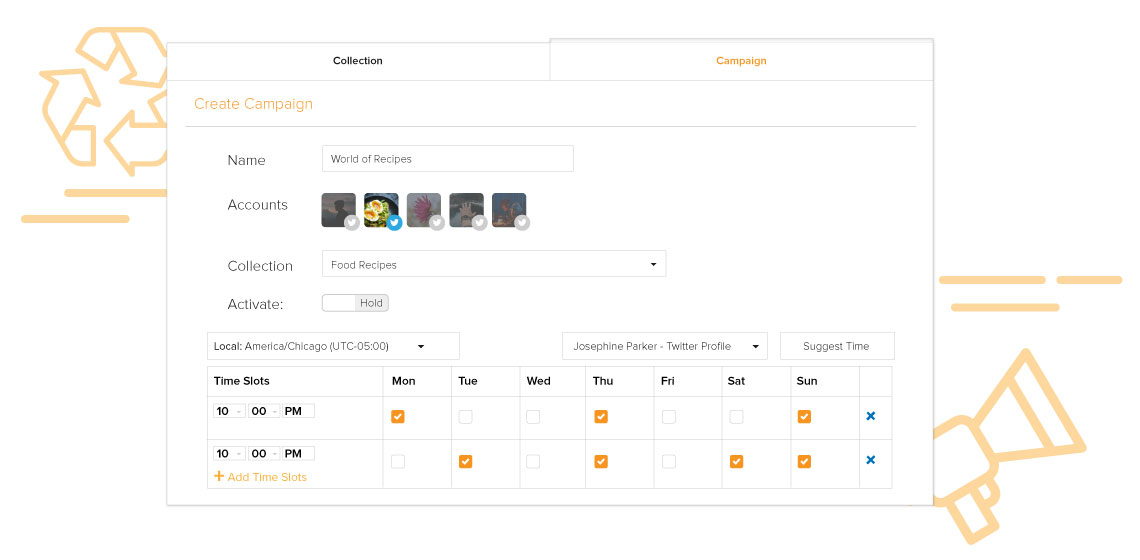Keeping up with community standards and regulatory requirements has become a routine part of a marketer’s daily grind nowadays. With everyone plugged into social media, it can be quite the task to ensure everything stays on the right track. That’s where content moderation comes in.
Effective content moderation is more important than ever as the amount of user-generated information grows and new technologies change how we communicate. Thankfully, social media management tools come in handy here. They let you organize, schedule, and analyze all your posts, minimizing the chances of any slip-ups.
To examine the current state of content moderation, this guide provides advice and best practices for overcoming the difficulties presented by a variety of international audiences, rapid technical development, and the ever-expanding field of digital expression.
What Is Content Moderation?
Content moderation refers to the practice of monitoring and managing user-generated content on digital platforms to ensure that it complies with community guidelines, legal regulations, and ethical standards.
Content moderation is essential to maintain a secure and encouraging online community, stop false information from spreading, shield users from unpleasant experiences, and protect the integrity and reputation of digital platforms.
A mix of artificial intelligence, automated tools, and human moderators who examine and grade the information per preset standards can be used to accomplish this process. One smart move to keep your social media platforms running smoothly is by diving into various AI tools for content management.
Ready to Master Content Moderation in 2024?
Social Champ is the answer! Get started with your social media management with the best AI-powered tool to ensure compliance and success.
What Does a Content Moderator Do?
To make sure user-generated content on different online platforms meets the rules and regulations, content moderators are in charge of monitoring it. Maintaining a secure and encouraging online environment for users is the major objective. Depending on the platform and its content policies, a content moderator’s particular responsibilities may change, but typically speaking, they include:
- Reviewing User-Generated Content: Content moderators assess text, images, videos, and other forms of content submitted by users to ensure it aligns with the platform’s guidelines.
- Enforcing Community Guidelines: Moderators enforce rules and policies by removing or taking action against content that violates the platform’s community guidelines, such as hate speech, harassment, violence, or other inappropriate content.
- Monitoring User Interactions: Moderators may also monitor user interactions, including comments and discussions, to identify and address any potentially harmful or inappropriate behavior.
- Responding to User Reports: Moderators often handle user reports, where users flag or report content that they find offensive or in violation of the platform’s rules. Moderators investigate these reports and take appropriate action.
- Maintaining a Safe Environment: Content moderators play a crucial role in creating a safe and welcoming online environment by filtering out harmful content and fostering positive interactions among users.
- Staying Informed: Moderators need to stay informed about evolving online trends and potential risks to effectively identify and address new forms of inappropriate content or behavior.
What Is AI Content Moderation?
Artificial intelligence (AI) content moderation is frequently used to supplement or improve human moderation efforts, offering a scalable and effective way to manage the massive amounts of user-generated content that internet platforms get.
Key Aspects of AI Content Moderation Include
- Text Analysis: AI algorithms can analyze text content to identify potentially offensive language, hate speech, or other violations of community guidelines. Natural Language Processing (NLP) techniques are commonly used for this purpose.
- Image and Video Recognition: AI can analyze images and videos to detect inappropriate or harmful content, such as nudity, violence, or graphic material. Computer vision technologies play a crucial role in image and video recognition.
- Pattern Recognition: AI algorithms can be trained to recognize patterns associated with specific types of content violations. This includes patterns in user behavior, such as repeated instances of harassment or spam.
- Scalability: AI-powered content moderation can efficiently handle large volumes of user-generated content in real-time, allowing platforms to manage content at scale without solely relying on manual moderation.
Related Article: Best Content Marketing Tools for 4usinesses in 2024
What Is Human Content Moderation?
Human moderators manually examine and assess user-generated content on online platforms as part of the process known as human content moderation. Ensuring that user-posted information conforms with the platform’s community norms, policies, and legal standards is the main goal of human content moderation. To give content review a more sophisticated and context-aware approach, human moderation is frequently used in conjunction with automated or AI-driven moderation.
Key aspects of human content moderation include:
Contextual Understanding
Human moderators bring a level of contextual understanding and cultural awareness that can be challenging for automated systems to replicate. They can interpret nuances, humor, and cultural references in a way that machines might struggle with.
Subjective Judgment
Human moderators can make subjective judgments about content that may be context-specific or require a deep understanding of the platform’s guidelines. This is particularly important for content that may fall into a gray area where automated systems might struggle.
What Is Automated Content Moderation?
One modern method for managing and reviewing user-generated content is automated content moderation. This method attempts to analyze, categorize automatically, and filter material according to established standards and policies specified by the platform using artificial intelligence (AI) and machine learning algorithms.
Automated content moderation can handle large amounts of user-generated text, photos, and videos in real time, offering a scalable solution for platforms with high user interaction. With an emphasis on efficiency and speed, the technology can identify and flag a variety of content infractions, including hate speech, violence, nudity, and spam.
Although automated systems are excellent at handling simple and routine cases, they may have trouble comprehending cultural quirks, sarcasm, or context, which could result in false positives.
What Is Social Media Content Moderation?
Social media content moderation involves the review, monitoring, and management of user-generated content on social media platforms to ensure it complies with the platform’s community guidelines, terms of service, and legal standards. It often involves a combination of automated content moderation tools powered by artificial intelligence and human moderation to effectively address the diverse and dynamic nature of social media content.
The challenges of social media content moderation include handling a vast volume of content, staying abreast of evolving online trends, and addressing issues related to free speech and cultural sensitivities.
Importance of Content Moderation in 2024
Several key factors highlight the significance of content moderation in 2024:
User Safety and Well-Being
Content moderation is essential to protecting users from negative experiences. Keeping an online environment safe is crucial, given the rise in user-generated content and safeguarding people from harm.
Compliance With Regulations
As digital platforms operate within a complex web of local and international laws, content moderation ensures compliance with these regulations. Staying abreast of legal requirements is crucial to avoid legal repercussions and to create a responsible and trustworthy online environment.
Preservation of Community Standards
By promoting a polite and constructive environment in online communities, social media content moderation aids in maintaining community rules and standards. By keeping an eye on and upholding these guidelines, platforms may promote a positive and welcoming user community.
Mitigating Misinformation
Content moderation is essential in this fast-paced age of information sharing to stop the spread of misinformation. Through the detection of inaccurate or deceptive material, digital platforms build a more knowledgeable and trustworthy online environment.
Protection of Brand Reputation
In order to draw and keep consumers, digital platforms—including social media networks—rely on a positive brand image. Efficient content moderation protects the reputation of the platform by promptly removing objectionable information.
Globalization and Cultural Sensitivities
Content moderation in 2024 requires recognizing and respecting cultural sensitivities while enforcing community guidelines is crucial to ensure inclusivity and prevent unintended cultural conflicts.
Pros and Cons of Content Moderation
Content moderation has both advantages and disadvantages. Here are some pros and cons:
Pros of Content Moderation
User Safety
Content moderation helps create a safer online environment by filtering out inappropriate, harmful, or offensive content. This protects users from harassment, hate speech, and other forms of online abuse.
Compliance with Laws and Regulations
Moderation ensures that platforms comply with local and international laws regarding content, such as regulations against hate speech, illegal activities, or copyrighted material.
Brand Reputation
Effective moderation helps maintain a positive brand image by preventing the spread of offensive or harmful content that could be associated with the platform.
Community Standards
Content moderation enforces community standards, building a healthy and respectful online community. It sets guidelines for acceptable behavior and content.
Prevention of Spam and Scams
Moderation helps in identifying and removing spam, scams, or fraudulent content, improving the overall quality of user-generated content.
Maintaining Advertiser Trust
Advertisers are more likely to trust platforms that actively moderate content, ensuring that their ads are not associated with inappropriate or controversial material.
Cons of Content Moderation
Freedom of Speech Concerns
Sometimes, being too strict with content moderation might accidentally stop people from expressing themselves freely. This could mean that important opinions or different points of view might not get heard.
Subjectivity and Bias
Moderation decisions can be subjective, leading to potential bias. Algorithms or human moderators may unintentionally favor certain perspectives, leading to accusations of censorship.
Resource Intensive
Implementing effective content moderation requires significant resources, both in terms of technology and human moderators. This can be challenging for smaller platforms with limited budgets.
False Positives and Negatives
Automated moderation systems may generate false positives (wrongly flagging content as inappropriate) or false negatives (allowing inappropriate content to go unnoticed).
Censorship Concerns
Content moderation decisions may be seen as censorship, sparking debates about who gets to decide what is acceptable and what isn’t.
Evolving Challenges
As online content and communication methods evolve, new challenges for moderation arise, making it difficult to keep up with emerging issues.
Balancing the pros and cons of content moderation is a complex task, and finding the right approach involves careful consideration of the platform’s goals, values, and user expectations.
Tips + Best Practices for Content Moderation
Perfect content moderation is crucial for maintaining a positive and safe digital environment. Here are some key tips to enhance the efficacy of content moderation efforts:
Clear Community Guidelines
- Establish comprehensive and clear community guidelines outlining acceptable behavior and content.
- Communicate these guidelines to users transparently, making them easily accessible on the platform.
Transparent Communication:
- Maintain open communication with users about the moderation process.
- Communicate the consequences of violating community guidelines, providing users with a clear understanding of expectations.
Regular Training for Moderators:
- Provide continuous training for human moderation teams to stay updated on evolving trends, cultural sensitivities, and platform-specific nuances.
- Ensure moderators are well-versed in the use of moderation tools and technologies.
Respond to all genuine messages and comments.
- Focus on removing spam comments and communications, freeing up your time to respond to actual users.
- Make sure no genuine communications are overlooked, it’s critical to review your filtered messages often. Reacting to impolite or inappropriate behavior is always a good idea. Just be careful not to become personal with them, and always maintain a professional demeanor.
- Naturally, some people are only interested in causing trouble and will never be happy with your response.
Adapt to User Trends:
- Stay informed about user trends, popular hashtags, and emerging content formats.
- Adjust moderation strategies to address new content types and user behaviors.
Featured Article: How to Get in Touch With LinkedIn Customer Service?
Best Practices for Content Moderations
Implementing best practices in content moderation is essential for having a positive and safe digital community. Here are key best practices to enhance the effectiveness of content moderation:
Proactive Community Guidelines
- Establish clear and comprehensive community guidelines outlining acceptable behavior and content standards.
- Communicate guidelines to users and ensure they are easily accessible on the platform.
Transparency and Communication
- Be transparent about moderation policies and communicate them clearly to users.
- Provide explanations for content removal or moderation actions to maintain user trust.
Consistent Enforcement
- Apply moderation rules consistently to all users, irrespective of their popularity or status.
- Avoid showing favoritism and ensure that rules are enforced uniformly.
Human Moderation Expertise:
- Invest in well-trained human moderation teams capable of understanding context, cultural nuances, and evolving trends.
- Empower moderators with continuous training to enhance their skills.
Conclusion
This Content Moderation guide serves as a compass, offering a comprehensive roadmap to foster a positive and secure online environment. The amalgamation of cutting-edge technologies, such as Artificial Intelligence and Natural Language Processing, with the nuanced judgment of human moderation teams exemplifies the synergy needed for effective content moderation.














